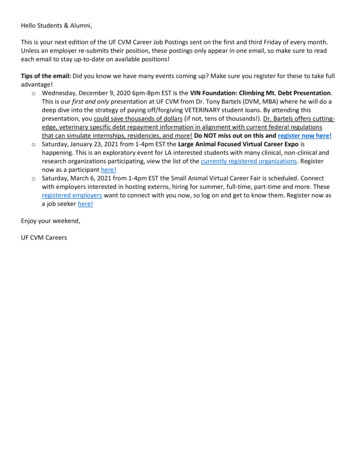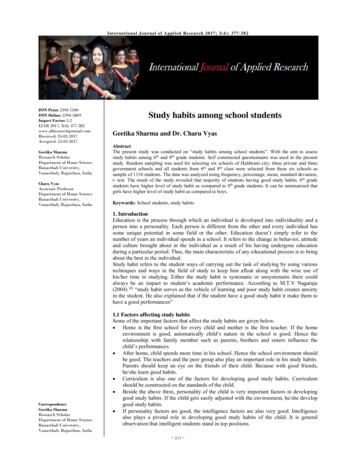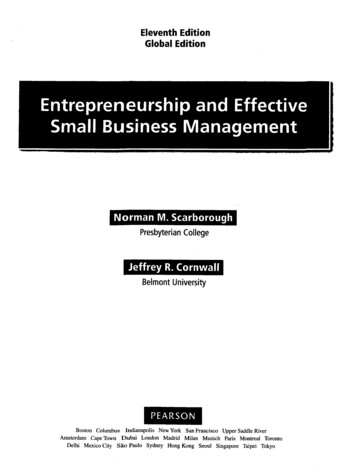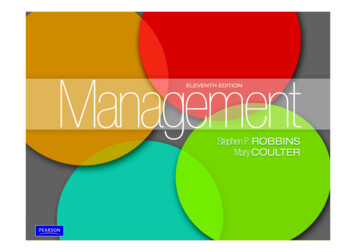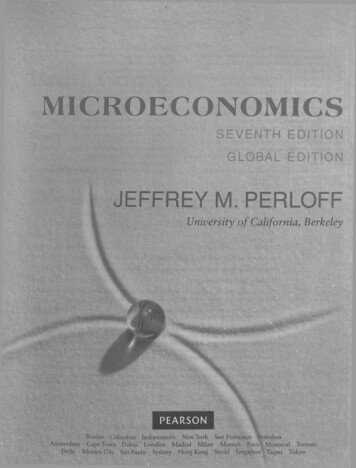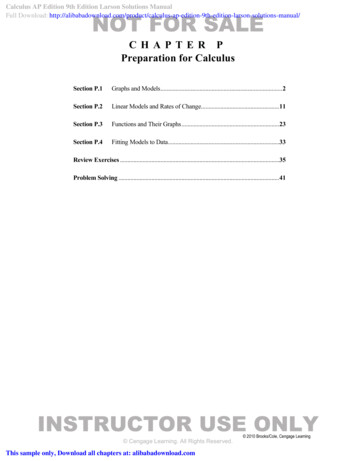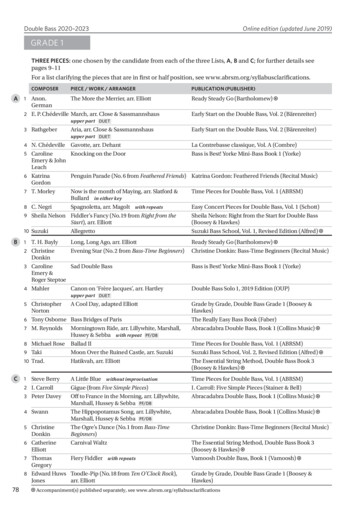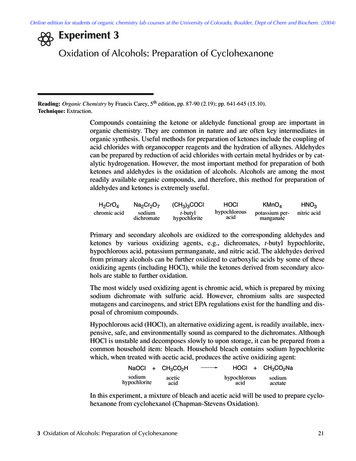
Transcription
Online edition for students of organic chemistry lab courses at the University of Colorado, Boulder, Dept of Chem and Biochem. (2004)3u ExperimentOxidation of Alcohols: Preparation of CyclohexanoneReading: Organic Chemistry by Francis Carey, 5th edition, pp. 87-90 (2.19); pp. 641-645 (15.10).Technique: Extraction.Compounds containing the ketone or aldehyde functional group are important inorganic chemistry. They are common in nature and are often key intermediates inorganic synthesis. Useful methods for preparation of ketones include the coupling ofacid chlorides with organocopper reagents and the hydration of alkynes. Aldehydescan be prepared by reduction of acid chlorides with certain metal hydrides or by catalytic hydrogenation. However, the most important method for preparation of bothketones and aldehydes is the oxidation of alcohols. Alcohols are among the mostreadily available organic compounds, and therefore, this method for preparation ofaldehydes and ketones is extremely useful.H2CrO4chromic hloriteHOClhypochlorousacidKMnO4potassium permanganateHNO3nitric acidPrimary and secondary alcohols are oxidized to the corresponding aldehydes andketones by various oxidizing agents, e.g., dichromates, t-butyl hypochlorite,hypochlorous acid, potassium permanganate, and nitric acid. The aldehydes derivedfrom primary alcohols can be further oxidized to carboxylic acids by some of theseoxidizing agents (including HOCl), while the ketones derived from secondary alcohols are stable to further oxidation.The most widely used oxidizing agent is chromic acid, which is prepared by mixingsodium dichromate with sulfuric acid. However, chromium salts are suspectedmutagens and carcinogens, and strict EPA regulations exist for the handling and disposal of chromium compounds.Hypochlorous acid (HOCl), an alternative oxidizing agent, is readily available, inexpensive, safe, and environmentally sound as compared to the dichromates. AlthoughHOCl is unstable and decomposes slowly to upon storage, it can be prepared from acommon household item: bleach. Household bleach contains sodium hypochloritewhich, when treated with acetic acid, produces the active oxidizing agent:NaOCl sodiumhypochloriteCH3CO2HaceticacidHOCl hypochlorousacidCH3CO2NasodiumacetateIn this experiment, a mixture of bleach and acetic acid will be used to prepare cyclohexanone from cyclohexanol (Chapman-Stevens Oxidation).3 Oxidation of Alcohols: Preparation of Cyclohexanone21
Online edition for students of organic chemistry lab courses at the University of Colorado, Boulder, Dept of Chem and Biochem. (2003)OH HOClO HCl H2OThe mechanism for this reaction has not been fully established, although the following seems likely:H:ClH: :H3HOClO HOClHOH OHH 2OHCl O HCl OH 2OHH3O Cl OHOH 2O Cl–H3O In order for the reaction of hypochlorous acid and cyclohexanol to go to completion,the hypochlorous acid must be in excess during the reaction. Since the concentrationof hypochlorite in household bleach varies, the presence of excess hypochlorousacid cannot be assumed by adding an excess based on the molar amount of cyclohexanol and assuming household bleach to be 5.25% sodium hypochlorite. Instead,the presence of hypochlorous acid must be established by a chemical test, the potassium iodide-starch test. This test employs paper impregnated with iodide ions andstarch (KI-starch test paper); a drop of the reaction mixture is placed on the paper. Ifhypochlorous acid is present, it oxidizes the iodide ion in the test paper to iodine,which in turn forms a blue-black complex with the starch in the test paper:HOCl H 2 KIstarch2 K Cl– H2O I2 starch (blue-black complex)At the end of the reaction period, any excess oxidizing agent must be destroyed.This is accomplished by the addition of sodium bisulfite (NaHSO3) which reducesexcess oxidant according to the equation below:HOCl HSO3- Cl- HSO4- H To determine if enough bisulfite has been added, the reaction mixture is again testedwith KI-starch test paper, this time, the absence of hypochlorous acid is the desiredresult.After neutralization with sodium hydroxide, the cyclohexanone is “salted out” byadding solid NaCl. Salting out is a common organic chemistry practice, based on the3 Oxidation of Alcohols: Preparation of Cyclohexanone22
Online edition for students of organic chemistry lab courses at the University of Colorado, Boulder, Dept of Chem and Biochem. (2003)principle that dissolved inorganic salts decrease the solubility of most organic compounds in water. The cyclohexanone is extracted into methylene chloride and theresulting solution treated with drying agent and heated to evaporate off the methylene chloride. High purity cyclohexanone could then be obtained by distilling theproduct, a method which would also help to identify the product by giving the boiling point. You will not have time to distill the product. Instead, you will run an IR ofyour product. The IR will indicate both the identity and the purity of your cyclohexanone.Safety PrecautionsConcentrated acetic acid, sodium hypochlorite, and sodium bisulfite are corrosive tothe skin. If you get any of these reagents on you, wash the affected area well withwater. While methylene chloride is rated as only a moderate health hazard, youshould still avoid contact with this reagent. Wear gloves and protective clothing.Sodium carbonate, cyclohexanol, and cyclohexanone are irritants—avoid skin contact.Procedure SectionPlace 10 mmoles of cyclohexanol and a stir bar in an Erlenmeyer flask. Place over astir motor and stir while you carefully add 2.5 mL of acetic acid (conc.). Place15 mL of bleach (approximately 5.25% sodium hypochlorite*) in your separatoryfunnel, position the separatory funnel above the Erlenmeyer flask, and add thebleach dropwise to the cyclohexanol/acetic acid mixture. The addition of bleachshould take about 15 min. If the reaction flask becomes hot to the touch during thebleach addition, use an ice bath to cool it down. When the addition of the bleach iscomplete, the solution will be pale yellow to yellow-green in color. Test the solutionfor excess hypochlorous acid and, if necessary, add additional bleach.Stir the reaction mixture for an additional 15 min at room temperature. Then,quench excess oxidant by adding about 0.5 mL of saturated sodium bisulfite solution.† Test for excess hypochlorous acid and, if necessary, add additional sodiumbisulfite.Add 2 drops of thymol blue (an indicator), then add 6N NaOH until the solution isjust basic. Add solid NaCl until the solution is saturated with salt, then decant theliquid into your separatory funnel. Extract with 5 mL of methylene chloride, savethe organic layer, then extract the aqueous layer one more time with 5 mL of methylene chloride.Caution: if the aqueous layer is warm, a lot of pressure can build up in the separatory funnel when it is shaken with methylene chloride. Be sure to vent yourseparatory funnel frequently during the extraction.* Sodium hypochlorite (NaOCl) is available only in solution. A 5.25% aqueous solution is5.25 grams of NaOCl in a total volume of 100 mL.† Saturated sodium bisulfite is approximately 30 grams of sodium bisulfite in 100 mL of water.3 Oxidation of Alcohols: Preparation of Cyclohexanone23
Online edition for students of organic chemistry lab courses at the University of Colorado, Boulder, Dept of Chem and Biochem. (2003)Combine the organic layers and dry over anhydrous sodium sulfate. Filter or decantto remove the drying agent. Remove the methylene chloride from the solution eitherby evaporating it on a steam bath (do not forget to add a boiling chip!) or by placingit in a side arm flask, stoppering it, and applying vacuum until bubbling is no longerapparent.Determine your yield and run an IR of the product.WastesAqueous Waste: The aqueous layer remaining after methylene chloride extractionand the test reagents.Recovery Jar: For the product, cyclohexanone.Study Questions1) If a procedure requires 10.0 g of HOCl, how many mL of 20% (aq.) NaOCl areneeded? (Hint: see the footnote in the Procedure section which defines “%”solutions.)2) Show the product that results when hypochlorous acid (HOCl) oxidizes eachcompound below. If no reaction occurs, write “No Reaction.”OHCH3CH2CH3OHCH3CH2HHCH3CH2CH2OH3) The IR spectra of cyclohexanol and cyclohexanone are given in Figure 3.1. Identify which spectrum belongs to which compound and assign the bands in eachspectrum to substantiate your choice.3 Oxidation of Alcohols: Preparation of Cyclohexanone24
Online edition for students of organic chemistry lab courses at the University of Colorado, Boulder, Dept of Chem and Biochem. (2003)Spectrum ASpectrum BFigure 3.1 The spectra of cyclohexanol and cyclohexanone. Whichis which?3 Oxidation of Alcohols: Preparation of Cyclohexanone25
Online edition for students of organic chemistry lab courses at the University of Colorado, Boulder, Dept of Chem and Biochem. (2003)3 Oxidation of Alcohols: Preparation of Cyclohexanone26
3) The IR spectra of cyclohexanol and cyclohexanone are given in Figure 3.1. Iden-tify which spectrum belongs to which compound and assign the bands in each spectrum to substantiate your choice. H CH2OH CH3CH2 OH CH3 CH3CH2 OH H CH3CH2

